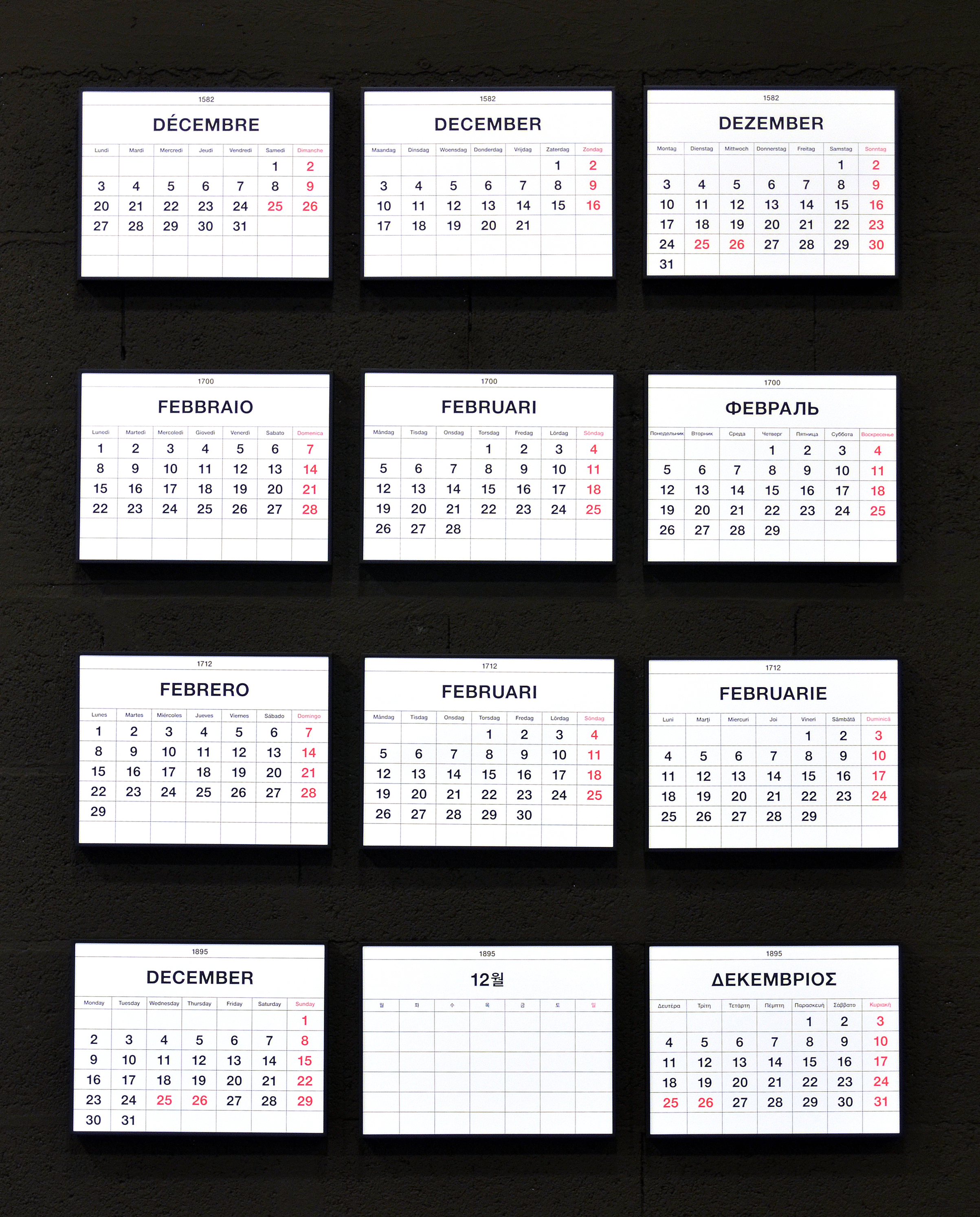Calendar
2020
22x29cm each
Silk Print on Paper

French, Belgian, and German calendars in December 1582
Italian, Swedish, and Russian calendars in February 1700
Spanish, Swedish, and Romanian calendars in February 1712
English, Korean, and Greek calendars in December 1895



Time is not absolute
but the way we recognize the time is absolute.
but the way we recognize the time is absolute.
Thanks to the progress of science, everyone knows time is not absolute. However, we still live under the same rule of time because of an unconscious desire for convenience. Also, since this calendar system is strongly accustomed to us, it is not easy to recognize that time is actually a system that dominates our ways of thinking.
What this work attempts is to expand our perspectives on what underlies our daily lives, and the system, particularly about time. I believe art can be an influential methodology to doubt systems we have believed in unconditionally for a long time and to ponder the coexistence of various systems in society.
This work shows when we have the most confusing calendar systems between countries in real history. Everyone will find strangeness from not only differences between calendars of the same months but also disappeared days. In this regard, this work reminds us that the calendar is an agreement that can be changed whenever as need. In the end, it is the beginning of recognizing the systems surrounding us and breaking our unquestioning belief towards them.
시간은 절대적이지 않지만,
우리가 시간을 인식하는 방식은 아직도 절대적이다.
우리가 시간을 인식하는 방식은 아직도 절대적이다.
과학의 진보 덕분에 모두가 시간이 절대적이지 않다는 것을 알고 있다. 그러나 편리함에 대한 무의식적인 욕망 때문에 우리는 여전히 절대적인 시간 규칙 아래에서 살고 있다. 특히, 우리는 현재의 달력 체계에 매우 익숙하기에 시간이 우리의 사고를 지배하는 하나의 체계임을 생활 속에서 인지하는 것은 쉽지 않다.
이 작품은 우리의 일상적인 삶이 무엇으로 이루어져 있는지와 시간 체계에 대한 우리가 가진 관점의 확장을 시도한다. 나는 예술이 우리가 오랫동안 무조건적으로 믿어온 체계에 의문을 품고, 사회에서 다양한 시스템의 공존을 고려할 수 있는 영향력을 가진다고 믿는다.
구체적으로, 이 작품은 국가 간에 달력 체계가 가장 두드러지게 차이가 나는 네 개의 시기를 보여준다. 이는 모두 역사적 사실에 바탕을 둔다. 같은 년도의 같은 달의 달력을 보여주는 네 개의 시리즈는 달력의 다른 모습 뿐만 아니라 사라진 날들에 대해 의문을 품게 한다. 그리고 최종적으로 달력이 필요에 따라 언제든지 변경될 수 있는 합의임을 우리에게 상기시킨다. 이는 곧 우리를 둘러싼 시스템을 인식하고 그에 대한 무비판적인 믿음을 부수는 시작이다.
Research
So how did we all end up using the same calendar?
To be unified by the Gregorian calendar system for most of the world, it took 341 years from 1582 to 1923. Honestly, the period would be longer as 434 years adding to Saudi Arabia's acceptance of the Gregorian calendar in 2016 with payment of 11 days.
Western countries switched from the Julian calendar to the Gregorian calendar to reduce the error of leap days. (Despite the introduction of these new calendar rules, errors still exist and are known to need modifications in the distant future.) Using the Gregorian calendar began in countries such as Italy, Spain, and Portugal together deleted 10 days in October 1582. Then it gradually spread to other countries for various reasons such as distance, religion, and war. In particular, it is surprising to know that Asian countries (Korea) had to pay for 55 days because they had used the lunar calendar, not the Julian calendar. Therefore, we can easily guess that the recognition and evaluation of the calendar system would have been quite different from nowadays when Greece started using the Gregorian calendar in 1932 as the last of the Western countries. Also, we can imagine the situation that even though each region has the same date, there were calendars with different information from this historical fact. Therefore, four different combinations of calendars which look very impractical present an unusual perspective on a system about time that we have never doubted in our lives or that we may always regard as flawless. Therefore, those pieces offer an opportunity to recognize the systems surrounding us and break our unconditional belief in them.

<Removed days for adoption of the Gregorian calendar>
© Yoonjae Lee